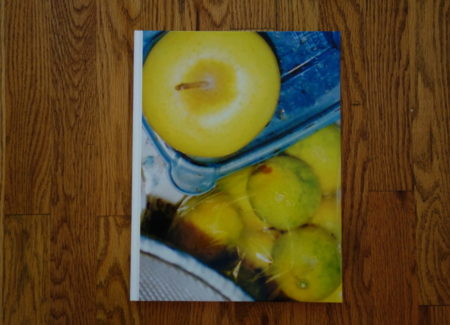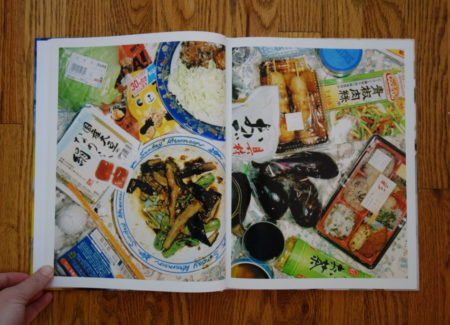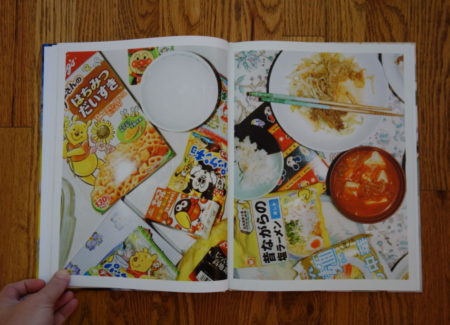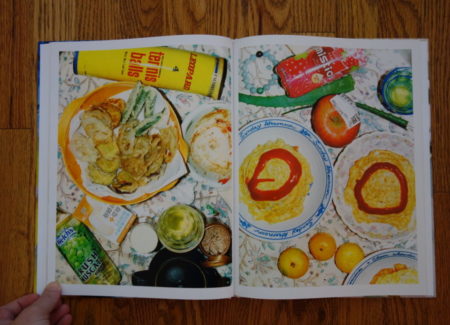JTF (just the facts): Published in 2016 by Newfave Books (here). Hardcover, 64 pages, with 49 color reproductions. There are no texts or essays included. In an edition of 500. (Cover and spread shots below.)
Comments/Context: During his travels around America in the early 1970s, Stephen Shore made a series of color photographs of his humble diner meals. Taken from above, they peered down at pancakes, scrambled eggs, buttered white toast, or a steak and baked potato, the plates, utensils, and formica tabletops providing the surrounding context for these everyday American still lifes. His pictures encouraged us to examine these overlooked meals more closely, to see both their resonant cultural motifs and their formal arrangements.
In his new photobook Still Life, Motoyuki Daifu’s cluttered Japanese tabletops reconsider this same idea, but with a renewed sense of messy energy. Daifu’s 2013 photobook Project Family (reviewed here) gave us a glimpse of the chaotic cramped quarters family life behind the usually neatly formal Japanese cultural stereotype, and this project continues his exploration of that flash lit overstuffed environment. In a small apartment where the kitchen table is by definition the center of the social (and culinary) activity, it’s no wonder that this location naturally becomes the landing spot for a dense patchwork of food and other recently used objects. But where others would find an ugly cacophony of unfinished consumption, Daifu has discovered a complex dance of visual forms and a gathering of items quietly emblematic of the frenetic pace of modern living.
Many of Daifu’s still lifes are anchored by a partially home cooked meal of some sort – noodles, vegetable dishes, rice, perhaps a breaded chicken cutlet, an omelet, or something fried – offered in and on a variety of round bowls and plates, or simply eaten directly out of plastic leftover containers. These foods are then augmented by an astonishing array of convenience store delicacies, from prepackaged sushi and dumplings to shrink wrapped buns and fish heads (many with the plastic bags and prices still on), and brightly packaged single serving treats like crackers, chips, and candies, adorned with smiling cartoon faces and bold graphics.
Natural and unnatural wrestle for dominance, with a tumble of oranges or tangerines rolling around loosely, flanked by an empty McDonald’s french fry carton or a watery plate of red sauced spaghetti, with everything washed down by a plastic bottle of juice, tea, or soda. Other random items, from a can of tennis balls and a box of Tweety bird branded tissues to condiment jars, chopsticks, toothpicks, and mosquito coils, add to the overall sense of engulfing communal disarray, each scene seemingly left just a moment ago by someone off in a hurry to do something else.
While it doesn’t appear that these found arrangements have been organized in any way, the camera’s flattening view of them uncovers layers of interlocked geometries, where rectangles and circles jostle and intermingle amid the eye popping color. Like Jan Groover’s elegant kitchen sink still lifes, Daifu’s scattered tabletops have their own kind of order and proportion, the space both unruly and surprisingly formal – in one symphony of circles, coffee cups, a strainer full of rice, a plated meal covered by plastic wrap, a bag of lemons, an apple, and a container of toothpicks all echo each other in shape, the composition gently pulling the viewer’s eye from one round object to the next.
Other visual motifs recur again and again. The straight lines of chopsticks, bony fish spines, forks, and asparagus spears slash across formal edges, breaking up and connecting geometric blocks. Happy cartoon faces peek out from the jumble, looking back at us from the action zone. And the entire area seems twisted and skewed, each item spun on its own axis, without regard to its relationship to any other item on the table – in this case, chance creates its own unifying clarity, the fixed space of the table continually crowded until the piles take over.
To many, Thai green curry soup in a box or Happy Morning Bread in a clingy bag might seem like discouraging nutrition choices, especially when followed by a handful of Chocoballs and a Red Bull. But these pictures seem to define a real kind of low budget, on-the-go home cooking that might be taking place more pervasively in Japan than we might want to admit, where yesterday’s meals are finished today, and a few knick knacks are picked up at 7-11 on the way home (after a long day at work) to fill out the flavors.
In the end, these well crafted images can be read at multiple levels – as all-over expressionistic density, as controlled formal interplay, and as subdued social commentary. Who knew that a cluster of leftover tofu, pre-cut melon in plastic, and a box of Winnie-the-Pooh cereal could deliver so much durable visual interest? To my eye, a selection of Daifu’s overbright tabletop tangles would do well enlarged even further (the book is already quite tall) or hung in a grid, as their forms will emerge with more force and vitality at massive scale or when balanced by like neighbors. This is a case when chaos resolves itself best when its too muchness threatens to overwhelm us.
Collector’s POV: Motoyuki Daifu is represented by Miyako & Rosen Gallery in Tokyo (where this body of work was shown in 2014 here) and Little Big Man Gallery in Los Angeles (here). His work has not yet reached the secondary markets with any regularity, so gallery retail remains the best option for those collectors interested in following up.




















